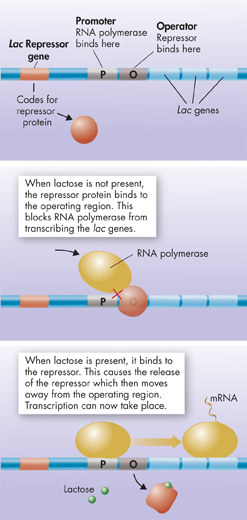The Lac Operon Why must E. coli be able to switch the lac genes on and off? Lactose is a compound made up of two simple sugars, galactose and glucose. To use lactose for food, the bacterium must transport lactose across its cell membrane and then break the bond between glucose and galactose. These tasks are performed by proteins coded for by the genes of the lac operon. This means, of course, that if the bacterium grows in a medium where lactose is the only food source, it must transcribe these genes and produce these proteins. If grown on another food source, such as glucose, it would have no need for these proteins.
Remarkably, the bacterium almost seems to “know” when the products of these genes are needed. When lactose is not present, the lac genes are turned off by proteins that bind to DNA and block transcription.

FIGURE 13–16 Gene Expression in Prokaryotes The lac genes in E. coli are turned off by lac repressors and turned on in the presence of lactose. Use Analogies How is the way lactose turns genes on and off similar to the way cold air signals a furnace to turn on or off?
ddPromoters and Operators On one side of the operon's three genes are two regulatory regions. The first is a promoter (P), which is a site where RNA-polymerase can bind to begin transcription. The other region is called the operator (O). The O site is where a DNA-binding protein known as the lac repressor can bind to DNA.
▸ The Lac Repressor Blocks Transcription As Figure 13–16 shows, when the lac repressor binds to the O region, RNA polymerase cannot reach the lac genes to begin transcription. In effect, the binding of the repressor protein switches the operon “off” by preventing the transcription of its genes.
▸ Lactose Turns the Operon “On” If the repressor protein is always present, how can the lac genes ever be switched on? Besides its DNA binding site, the lac repressor protein has a binding site for lactose itself. When lactose is added to the medium, it diffuses into the cell and attaches to the lac repressor. This changes the shape of the repressor protein in a way that causes it to fall off the operator. Now, with the repressor no longer bound to the O site, RNA polymerase can bind to the promoter and transcribe the genes of the operon. As a result, in the presence of lactose, the operon is automatically switched on.
Table of Contents
- Formulas and Equations
- Applying Formulas and Equations
- Mean, Median, and Mode
- Estimation
- Using Measurements in Calculations
- Effects of Measurement Errors
- Accuracy
- Precision
- Comparing Accuracy and Precision
- Significant Figures
- Calculating With Significant Figures
- Scientific Notation
- Calculating With Scientific Notation
- Dimensional Analysis
- Applying Dimensional Analysis




